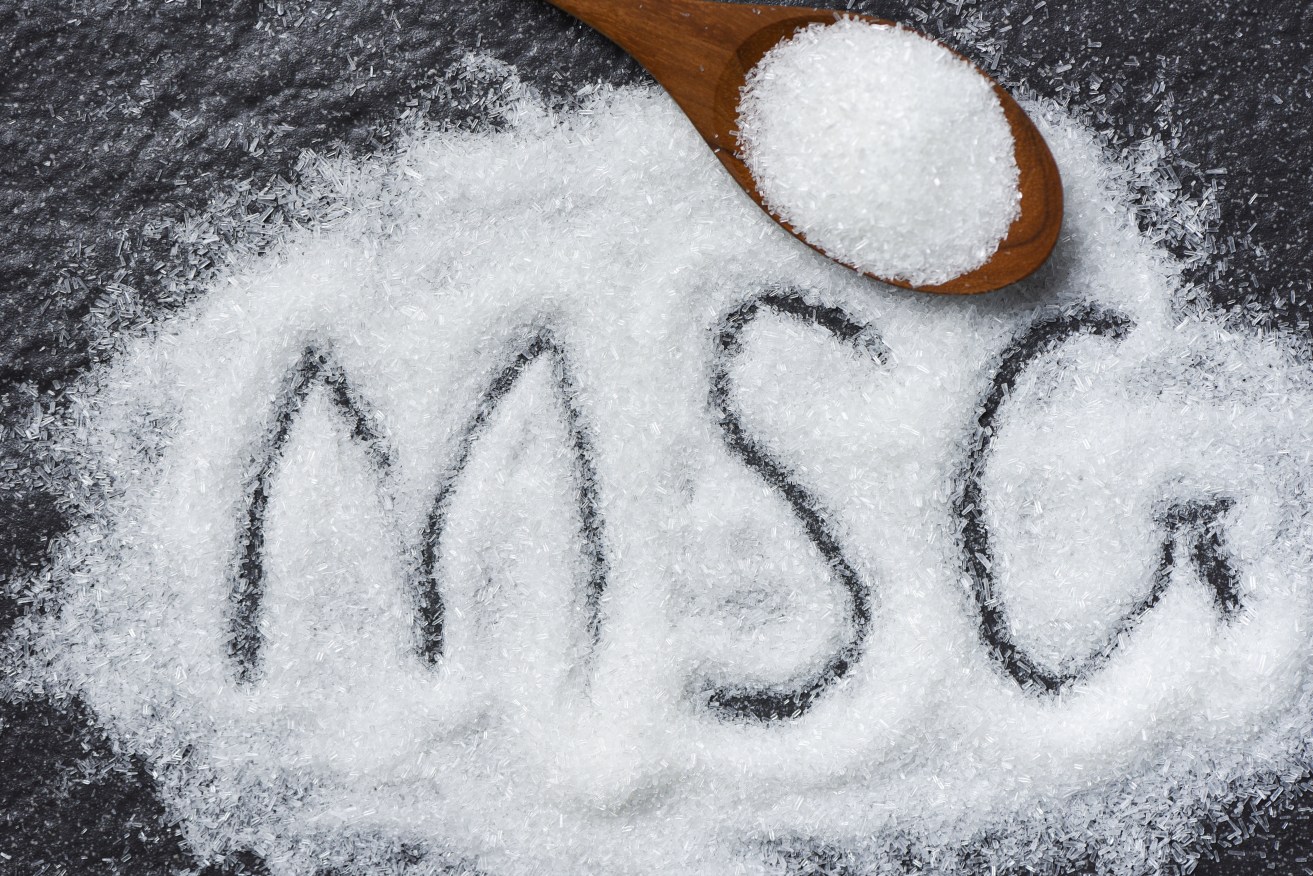The truth about MSG, a much-maligned source of great flavour


Food Standards Australia New Zealand advises that MSG won't make you seriously ill or kill you. Photo: Getty
In the 1980s and 90s it was common practice when ordering dinner at a Chinese restaurant to ask that no MSG be used in the cooking.
This sometimes brought a scowl or a mutter from the waiter that MSG wasn’t a problem.
But some restaurants, keen to keep anxious customers happy, posted signs: “NO MSG.”
The morning after
The next morning, after your Chinese dinner, with a pot of tea at hand, you happily spread Vegemite on your toast. The beloved national spread, however … effectively contains MSG.
At lunchtime, you have a hankering for spaghetti with a good sprinkling of parmesan cheese, which … also contains MSG. (I’ll explain this further.)

Amiable cook Adam Liaw is cranky about MSG’s dodgy reputation. Photo: Getty
In fact, in 2015, the Sydney Morning Herald reported food manufacturers and supermarkets were labelling dozens of products as being MSG-free – when they contained ingredients such as hydrolysed vegetable protein and yeast extract, which are chemically the same as MSG when dissolved in water.
Given the food additive’s reputation for poisoning our kidneys and hearts, causing brain lesions, obesity, asthma, not to mention Chinese Restaurant Syndrome, it’s a wonder we haven’t all collapsed with a chopstick or spaghetti fork in our hands.
Shouldn’t the government do something?
Regulatory bodies here and abroad deem MSG to be apparently safe, but not always in language that puts the mind at ease.
Food Standards Australia New Zealand advises that “there is no convincing evidence that MSG is a significant factor in causing systemic reactions resulting in severe illness or mortality”.
In other words, it won’t make you seriously ill or kill you.
However, the regulatory body notes that: “Even so, a very small number of people who are sensitive to a range of foods, especially those with asthma, may be sensitive to glutamate.”
So… what is MSG?
Monosodium glutamate (MSG) is a white, odourless, crystalline powder commonly used as a food additive – although labelling often disguises the fact because of MSG’s notorious reputation.
MSG, originally fermented from kelp, is now made by fermenting the sucrose in sugar beets, sugar cane and molasses.
When dissolved in water, MSG separates into sodium and free glutamate.
It’s the glutamate in monosodium glutamate (MSG) that causes all the trouble, while the sodium component allows MSG to be used as a healthier salt alternative.
So what is glutamate?
Glutamate, also known as L-Glutamate, is the most abundant free amino acid in brain and it is the major excitatory neurotransmitter of the vertebrate central nervous system.
According to a sober explainer at The Conversation, glutamate is used chiefly in our body to make protein.
In the explainer, Monash University Professor Merlin Thomas, a physician and researcher, advises:
“Most of us normally eat around 10 grams of glutamate every day, much of which is released into the body when we eat and digest protein. Some protein-rich foods – such as meat, fish, chicken, dairy products, legumes and corn – are especially rich in glutamate.”
Glutamate tickles our taste buds
But not just any glutamate, says Professor Thomas: “We can’t taste glutamate that is locked in protein. For it to tickle our taste buds, it must be in a ‘free form’.”

Soy sauce is one of many products high in glutamate. Photo: Getty
Professor Thomas notes that some tasty foods – such as tomato products, fermented sauces (soy, fish, oyster, steak and Worcestershire sauces) and long-matured cheeses such as stilton and parmesan – are high in free glutamate.
He writes: “Ever wonder why parmesan makes the bolognese taste better (and more meaty)? It’s the glutamate!”
Professor Thomas says most of us would usually eat around half to one gram of free glutamate every day.
“In Asian countries, this figure is double, reflecting the use of soy and other fermented products in cooking. A highly-seasoned banquet in a Chinese restaurant may contain up to four to five grams of free glutamate,” he writes.
The origin story
Given the long-standing whiff of anti-Chinese racism surrounding MSG, it might surprise you to learn that it was actually a Japanese discovery.

Professor Kikunae Ikeda, father of umami.
In 1908, a Tokyo Imperial University professor of chemistry, Kikunae Ikeda, tried to replicate the savoury taste of his wife’s dashi broth.
In doing so, he became a culinary hero for uncovering the chemistry of what he christened “umami”.
Umami is known as the fifth flavour, alongside sweet, bitter, sour and salty.
The key to the professor’s discovery was isolating glutamate – derived from glutamic acid – that resided in the kelp that his wife used to make her wonderful broth.
There’s no chemical difference between the glutamic acid found naturally in some foods and that found in MSG. This means your body can’t differentiate between the two types.
So when did the trouble start?
In April 1968, The New England Journal of Medicine (NEJM) published a letter from a Maryland doctor named Robert Ho Man Kwok that advised that he’d eaten in Chinese restaurants in Europe and Asia with no problem.
But after eating in Chinese restaurants in the US, he’d experience numbness at the back of his neck. This would spread to his arms and back.
He also complained of a general weakness and heart palpitations. All this amounted to a suggestion he’d suffered an allergic reaction.
But allergic to what? Soy sauce?
No, he cooked with soy at home. Maybe it was the heavy-handed use of Chinese cooking wine or too much sodium or perhaps the flavour-enhancing MSG?
The letter was followed up in a piece in The New York Times unfortunately titled “‘Chinese Restaurant Syndrome’ Puzzles Doctors”.
Meanwhile, other people were writing to the NEJM with their own stories of feeling flushed or suffering headaches after eating Chinese food.
Chinese restaurant owners strove to make an obvious point: each had seen hundreds, even thousands of customers over the years. Where were the multitudes clutching their throats?
In short order, a neuroscientist named John Olney published an MSG study in Science. When he’d injected MSG into mice, they’d developed brain lesions and impaired development.
A flood of poorly designed research
And so began a flood of small studies that often involved giving mice and other animals extremely high doses of the MSG. These were countered by rigorous studies that concluded MSG in food wasn’t causing lesions or brain dysfunction. As a 2018 analysis concluded:
- The ingestion of MSG in the diet does not produce appreciable increases in glutamate concentrations in blood, except when given experimentally in amounts vastly in excess of normal intake levels.
- The blood-brain barrier effectively restricts the passage of glutamate from the blood into the brain, such that brain glutamate levels only rise when blood glutamate concentrations are raised experimentally via non-physiologic means.
In the meantime, MSG is linked to asthma attacks and obesity and the impolitely named ‘Chinese restaurant syndrome’.
“Despite concerns raised by early reports, decades of research have failed to demonstrate a clear and consistent relationship between MSG ingestion and the development of these conditions.”
But some people…
In his Conversation piece, Professor Merlin Thomas notes that a small proportion of people “experience transient symptoms when they consume large amounts of free glutamate (more than four to five grams) in a single meal”.
He notes that these reactions “vary from person to person but may include headaches, numbness/tingling, flushing, muscle tightness and general weakness”.
Studies that have tried to replicate this experience “have been too small, used unrealistically high doses of MSG, and were not undertaken in the context of food (or even with intravenous doses)”.
More rigorous studies have failed to confirm a reproducible response to meals containing MSG, even in self-attributed ‘MSG sensitive’ individuals.
“Most reactions to a Chinese banquet probably have little to do with the MSG, as many of the same people who are ‘MSG sensitive’ have no problems with Vegemite or parmesan cheese,” Professor Thomas writes.
What does the cook say?
The MSG issue has been grinding the gears of an otherwise amiable Adam Liaw for years.
The absolute easiest thing most people could do to immediately improve the taste of their cooking is start using MSG. No kidding.
It should be as basic to seasoning as salt or sugar, and that most of us don't use it based on old, debunked misinformation is quite ridiculous.
— Adam Liaw (@adamliaw) November 27, 2022








